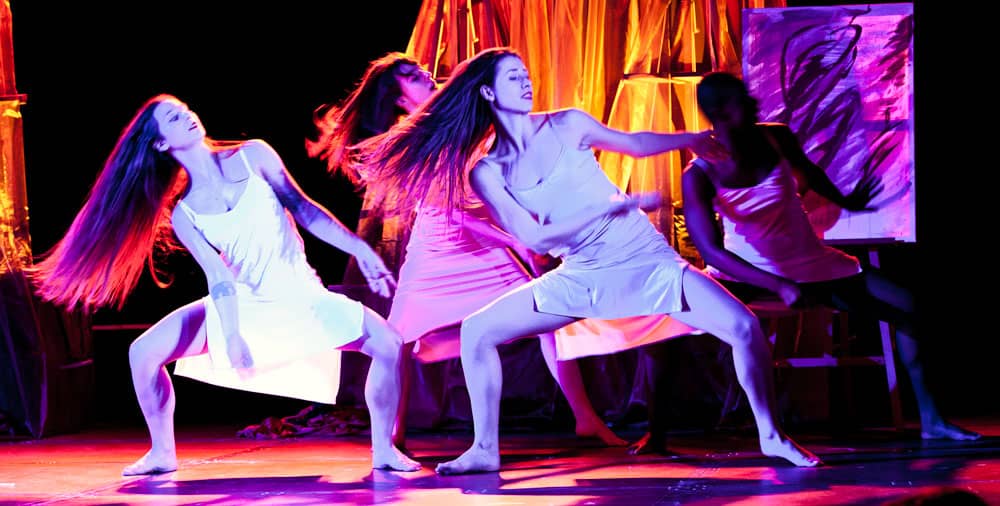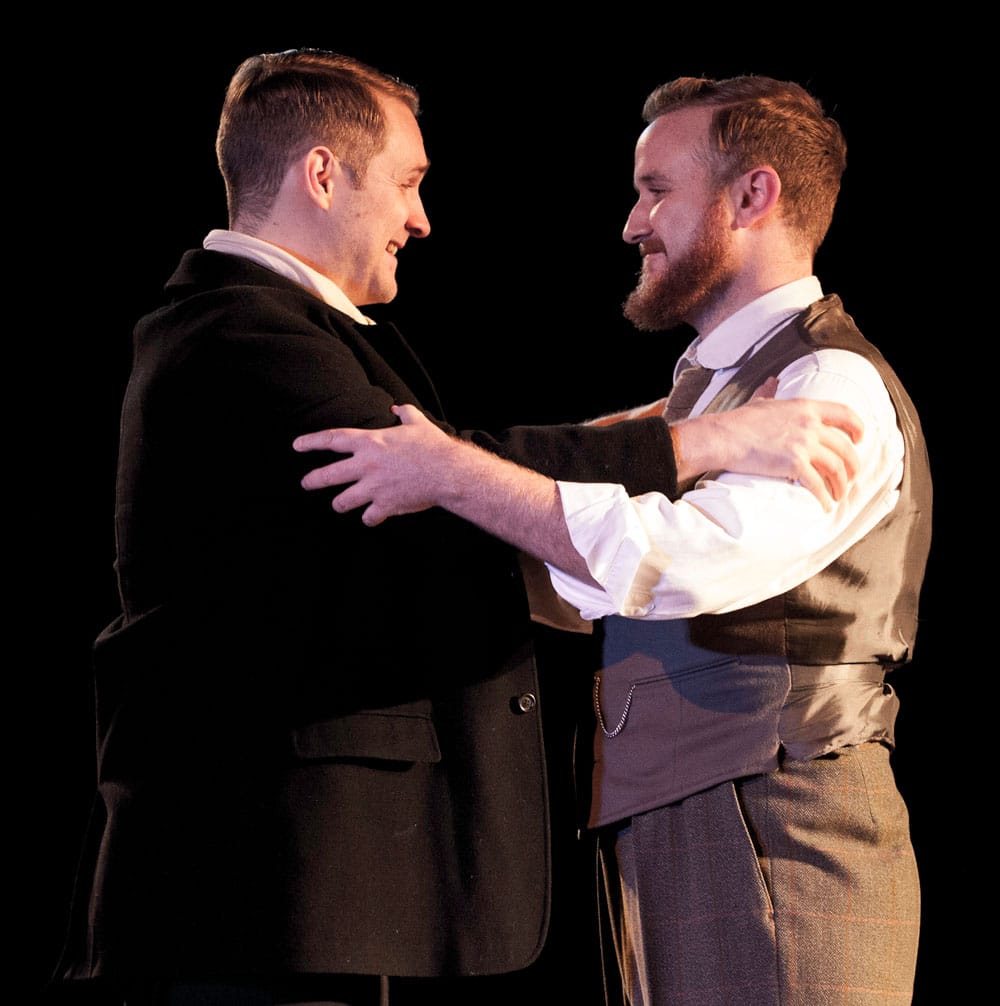The Travelling Companion
“An accomplished revival of a little-known gem, greatly to the credit of the ever-enterprising New Sussex Opera. The music has wonderful vigour and charm. The soloists are all admirable, and Paul Higgins has done a sensibly unfussy job of staging the piece”.”
**** Rupert Christiansen
“Here is a highly accomplished work, not quite like anything else, which deserves to come into its own.
The strength of NSO’s production stemmed from director Paul Higgins’ decision to anchor the action in magic-realist 1916 England, rather than some flimsy Land of Faery. His keenly motivated staging was heightened by Isabella Van Braekel’s evocative costuming. In particular, the crucial colloquies for John and his Companion were projected as intensely as they are composed. They were strongly sung too. Julien Van Mellaerts possesses a distinctive, birch-grained baritone, subtle verbal skills and a generous presence which made him a model, Housman-esque Companion. David Horton’s vibrant lyric tenor is not yet the finished article, but his voice is right for the everyman-hero and John’s ‘Brother of Men’ aria was fervently delivered. Stanford’s Princess needs to combine French refinement with Straussian wallop, and Kate Valentine’s meaty lyric soprano came good in her forceful, nocturnal monologue, struggling to steel her goblin-hardened heart against the vocalised ‘conscience’ of the Companion. This was a memorable scene, stirringly done.
Felix Kemp’s lyric baritone made an excellent impression with the Herald’s smiling, bureaucratic urbanities. Ian Beadle’s saturnine, Rimskian Wizard presided over the dream kingdom – and Stanford’s pretty ballet, all floaty silk and Parisian odalisques – with hirsute arrogance. Toby Purser conducted his proficient orchestra from behind the stage, which created problems for a handful of tricky choral entries, but ensured a smooth theatrical flow for one of NSO’s most visionary revivals.”
Christopher Webber
“The conductor Toby Purser, the orchestra and the leads – notably Kate Valentine as a princess with a Turandot complex and Julien Van Mellaerts as the (possibly angelic) Travelling Companion – went at it with absolute sincerity and a real sense of Stanford’s lyrical idiom.”
Richard Bratby
““Fine performances… Narrative values are good and the substantial chorus works hard and to impressive effect.” George Hall
“Among The Travelling Companion’s many delights was the orchestral music – the prelude and postlude, the atmospheric interludes between scenes, and the ballet music in Act 3. It was sobering to think there must be a lot of similarly strikingly orchestrated and beautifully written music by Stanford that has not been heard for nearly a century.” Janet Banks
“Tom Turner’s lighting was so economical, effective and enchanting”
“One thing that was instantly noticeable was the excellent diction of both soloists and chorus”
“David Horton’s wonderfully expressive diction, lovely tone and strong characterisation were heart-warming: we were ‘with him’ from the first.”
“As the resurrected Fairy Godfather, Julien Van Mellaerts used his lovely, beguiling tone and dramatic nous to make us warm to this Nick Shadow with good intentions.”
“Toby Purser’s leadership was an example of the sort of preparation, proficiency and good engagement with musical colleagues that companies such as NSO need but don’t always get.”
Claire Seymour
“Under Toby Purser’s sympathetic direction the orchestra gave a fine account of Stanford’s richly expressive, late Romantic music. David Horton sang with lovely straight, lyric tone and brought out the plaintive nature of John’s need for a friend. Julien Van Mellaerts sang with engaging tone. Yet in the few occasions when The Travelling Companion shows his otherworldly powers, such as the scene where he hears and mysteriously echoes the princess’s inner thoughts, he hinted at the character’s hidden depths. Kate Valentine made the princess a surprisingly human character, she is plagued with doubts and it is this aspect that the opera concentrates on. There is a ‘Boys Own’ quality to the piece and the princess is more of a cypher for the ideal rather than a human, yet Valentine made us care for her. Felix Kemp made a noble herald. Ian Beadle had great fun with the Wizard’s scene, Felix Kemp and Ian Beadle also doubled most effectively as the ruffians in the first act. New Sussex Opera’s non-professional chorus grasped the opportunities with enthusiasm and vigour. There are two solo roles taken from the chorus, most effectively played by Tamzin Barnett and Lucy Urquhart. New Sussex Opera has again dared to go where others have not, and has done so with immense style.” **** Robert Hugill
“New Sussex Opera continues to set the pace in terms of unfamiliar operas, imaginatively staged. That so resourceful and apposite a presentation is feasible given the limitations of Cadogan Hall’s stage says much for the expertise of this production team as a whole. The third Act brings out the best in Paul Higgins’ direction, the stage-action galvanised with Tom Turner’s suitably lurid lighting and Roseanna Anderson’s dextrous choreography. Vocally, too. David Horton has all the necessary fervency and naive fearlessness as John, as does Julien Van Mellaerts a strength and eloquence in the title-role – a ‘friend in need’ in time of crisis. Kate Valentine evinces ardour but also the requisite self-doubt as the Princess, complemented by the sombre bemusement of Pauls Putnins as the King, while Ian Beadle brings suavity to the role of the Wizard and Felix Kemp a ceremonial authority to that of the Herald – the latter two doubling effectively as ruffians in the first Act. The NSO Chorus makes the most of its lively contributions, while Toby Purser secures a vigorous and always-attentive response from the NSO Orchestra – with warmth and not a little lightness of touch.”
**** Richard Whitehouse
There were strong performances from the solo cast, and in particular from Julien Van Mellaerts (the travelling companion) and Ian Beadle (the wizard). Given his mastery as a choral writer for the English church, it’s hardly surprising that Stanford integrated the chorus so successfully into the action. The New Sussex Opera Chorus provided enthusiastic commentary throughout enhanced by the orchestra conducted by Toby Purser. At times, the orchestra obscured the finer detail of the solo singing, a problem caused by the lack of a pit in the venue, but on the other hand, having the orchestra on stage provided extra energy to the overall performance.
Another highlight worth mentioning was the ballet music provided for by Stanford in the score and colourfully interpreted by dancing goblins (choreographer, Roseanna Anderson) and an effective lighting design (by Tom Turner). The last performance was captured for release by SOMM records. Una Hunt
Accordion Content
Two virtues repeatedly impress: the orchestration’s dashing Mendelssohnian brilliance, and the extraordinarily dexterous word-setting, which should long ago have buried the vulgar lie that no composer between Purcell and Britten knew how to treat English verse. Nowhere does the musical argument fall below a high level of charm and resourcefulness. Some of it is downright wonderful.
Every single soloist and chorine demonstrates first-rate diction (and Newbolt’s text really is worth hearing). Toby Purser conducts everything with obvious love. At least one reviewer found himself moist-eyed at the concluding bars. R J Stove
If anything would help place Stanford’s work where it truly belongs, it will be through recordings such as this, a live performance captured in full, astonishingly well caught in very good sound. The excellent commitment of the participating artists combines to produce a fully convincing account of a compelling score.
The principals are splendid: David Horton and Julien Van Mellaerts, especially, with Pauls Putnins’ King equally outstanding; Kate Valentine as the Princess is also a part most convincingly taken – as indeed are all the other soloists. The orchestra also plays well throughout, and Toby Purser’s overall conducting is admirable in terms of balance, tempos and pacing of each scene: clearly a labour of love from all concerned, not least Siva Oke’s sound production and her company’s presentation. This is a very important issue, and is much recommended. Robert Matthew-Walker
Charles Villiers Stanford
Opera in Four Acts
after a story by Hans Christian Andersen
Libretto by Henry Newbolt
November/ December 2018
Lewes Town Hall
Devonshire Park Theatre, Eastbourne
Cadogan Hall, London SW1
Saffron Hall, Saffron Walden
(recorded live by SOMM
and now available here)
Production supported by The Stanford Society
NSO’s production of The Travelling Companion was nominated in the Rediscovered Work category of the
International Opera Awards 2019
John David Horton
The Travelling Companion –
Julien Van Mellaerts
The Princess Kate Valentine
The King Pauls Putnins
The Wizard Ian Beadle
The Herald Felix Kemp
Two Ruffians Ian Beadle, Felix Kemp
Two Girls Tamzin Barnett, Lucy Urquhart
NSO Chorus and Orchestra
Conductor Toby Purser
Director Paul Higgins
Designer Isabella Van Braeckel
Lighting Designer Tom Turner
Choreographer Roseanna Anderson
Assistant Conductor Ben Knowles
Photographs – Robert Knights
CLICK HERE TO SEE THE PROGRAMME BOOK
A mysterious stranger, a princess, a wizard’s riddle, with haunting, romantic music: the exciting re-discovery of Charles Villiers Stanford’s last and arguably finest opera. This was the first professional production of the work for over eighty years, culminating with a live recording of the final performance by SOMM, NSO’s first recording to mark the fortieth anniversary year, and also the first recording of any of Stanford’s nine operas – a key event in the current renaissance of interest in his music.



















